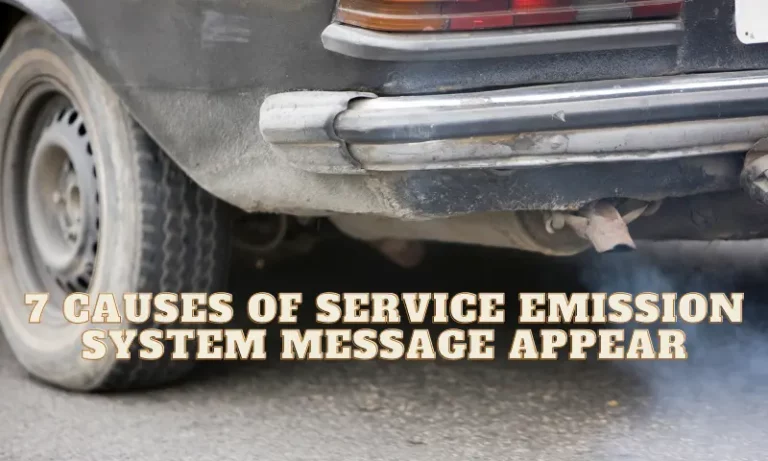The service emission system message can appear on your dashboard anytime, regardless of the car’s age. Don’t panic if this has happened to you for the first time. Your vehicle has an emission control system that helps reduce pollution. Therefore, the message means that there’s an issue within the system that you need to repair.
Luckily, it’s easy to resolve the error if you know the cause. We will help you determine what might have triggered the message and how to fix it.
What Causes the Service Emission System Message?
Many issues cause the service emission system message. They include a loose gas cap, a manifold leak, or a dirty air filter. A defective oxygen sensor or damaged catalytic converter will also cause a malfunction in the emission control system.
Note: The error message may be a force positive, although rare. For that, try to reset the Powertrain Control Module (PCM) first and see if the message disappears. Disconnect the battery for about 15 minutes; the error might clear after reconnecting the power.
A Loose Gas Cap
One possible cause of the error message is a loose gas cap. That sometimes happens after a fuel fill-up. The gas cap can break or suffer other damage besides being loose. The cap could also be missing leaving the filler neck open.
When that happens, you’re most likely to get the “tighten gas cap” message, depending on your car model. However, sometimes a fault on the gas cap will trigger the service emission system notification.
How to Fix: Examine the fuel cap for inconsistencies and adjust and tighten it properly if it’s slightly off threads or loose. If it’s missing or broken, do a replacement, which goes for about $25 on average. You can also replace the gasket or fuel cap lining if worn out.
Failing Air Filters
Your car has an air filter that helps to keep impurities from entering the engine. With time, this filter gets dirty and clogged. When that happens, the airflow decreases, causing issues in your machine. That’s because, the engine requires a specific amount of air and fuel to generate the necessary power.
A clogged filter also causes an imbalance in the air-fuel ratio. As a result, your vehicle may experience power loss and dirty smoke. Ultimately you will get the service emission system message. Note that you may see this message instead of or along the typical check engine light. It depends on your car model.
For diesel engines, there’s what specialists call Diesel Particulate Filter (DPF). As the name suggests, it helps to trap diesel particulate matter from the exhaust. The filter can also clog and fail, triggering the warning message.
How to Fix: You need to change the failing filter. Professionals recommend replacing the air filter every 12,000 to 15,000 miles. You may need to change the filter soon if you drive in dusty conditions. This exercise will cost you anywhere from $20 to $75 if you DIY.
Manifolds Leak
Your exhaust could have developed a crack or hole and causing fuel vapor to escape into the atmosphere. There may also be damage to the gasket. The intake manifold may also have loosened, leading to a leak. Either way, the engine emission control system will detect the fault and turn on the warning light.
How to Fix: You must physically examine the manifolds for any faults. It could be something as simple as a loose bolt, clamp, or worn-out gasket. A leak at the gaskets will need gasket replacement. You can repair a leaky exhaust temporarily using epoxy or welds. Alternatively, you can install a new manifold to fix the problem permanently.
Note: Finding a leak on the manifolds can be a laborious and time-consuming task for a DIYer. You may require the help of a reliable mechanic.
A Faulty Sensor
Your vehicle’s Emissions Control System relies on several sensors to perform its task. The most common ones are the mass air flow sensor (MAF sensor) and oxygen sensor.
The MAF sensor measures the amount of air moving into the engine through the intake manifold. It helps to ensure that a balanced air-fuel mixture is entering the engine. On the other hand, the oxygen sensor (O2 sensor) monitors the amount of oxygen coming through the exhaust. Most cars have at least two O2 sensors.
If one of these sensors fails, the system will know and alert you through a check engine light. Sometimes the alert could be the service emissions system message.
How to Fix: You’ll need to replace the defective sensor. It’s not easy to determine what sensor exactly is faulty. An OBD II scanner will help to read the codes for easier identification. You can then refer to your owner’s manual to interpret the codes.
Problematic EGR System
The EGR (exhaust gas recirculation) system is a critical part of the emission control in your vehicle. This system reduces nitrogen oxide (NOx) by recirculating some of the exhaust into the engine.
If there’s an issue in the EGR, the engine control unit will turn on the service emission system warning light. The issue could be a defective EGR bypass valve or a wiring problem.
How to Fix: Connect an OBD II scanner to help you identify the error fast and more accurately. The scanner will show DTC codes P0406 and P2495 related to the EGR system. Repairs include replacing the faulty bypass valve, which may not be a DIY task.
DEF-Related Problem
Diesel Exhaust Fluid (DEF) is a special solution composed of water and urea. It’s injected into diesel engines’ exhaust systems (Selective Catalytic Reduction) to convert NOx gases into less harmful emissions.
If an issue happens in the system, you’ll get a notification through the check engine light or the service emission system message. A DEF-related problem commonly occurs after filling the DEF tank using some DEF fill equipment.
How to Fix: The warning light should clear shortly after filling. Make sure the vehicle remains keyed on until the error clears. You can reduce the likelihood of encountering the error by always keying off the car during filling.
Defective Catalytic Converter
A catalytic converter (Cat) is a wear-and-tear item. It typically has a lifespan of up to 100,000 miles. However, it can become damaged before that, depending on how you drive your car. The cat is a critical component of emission control.
It helps to convert harmful exhaust gases into something safer for the atmosphere. The system will send the error message in your instrument cluster when the part fails. The error contains a code P0420.
How to Fix: You need to perform a cat replacement, one of the most expensive repairs. It could cost you over $2,000, depending on your vehicle model.
Conclusion
As mentioned, you don’t need to get anxious if you see the service emission system message on your dashboard. There’s no immediate danger. It could be a force positive, a loose fuel cap, and other easy-to-fix problems discussed above.
The probability that the cause is a damaged catalytic converter is small because cats can last a lifetime. Please seek the help of a reliable specialist for accurate diagnosis and fix if you can’t handle it yourself.



